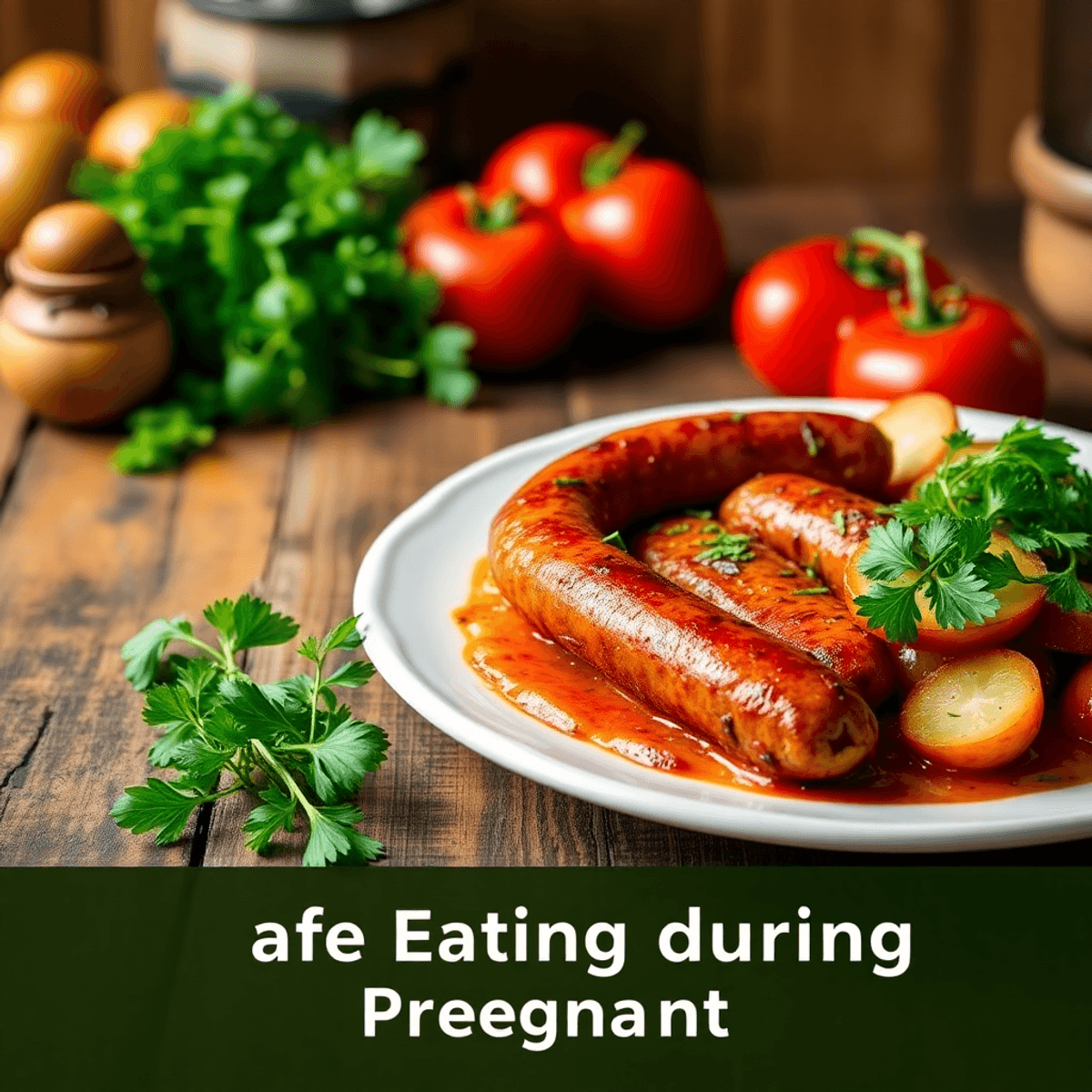Introduction
Pregnancy brings countless questions about food safety, and Italian sausage often sparks uncertainty among expectant mothers. You’re not alone in wondering “Can pregnant women eat Italian sausage?” This guide will help you navigate the complexities of enjoying this popular meat product during pregnancy.
Making informed dietary choices becomes crucial when you’re eating for two. Your food selections directly impact your baby’s development and your own health. The right nutritional choices support optimal fetal growth while keeping you healthy throughout your pregnancy journey.
Many myths surround pregnancy nutrition:
- “You must avoid all processed meats”
- “Sausage is completely off-limits”
- “Only organic meats are safe”
These blanket statements oversimplify the reality. The truth about Italian sausage consumption during pregnancy lies in understanding proper preparation, cooking methods, and portion control. You’ll discover how to safely incorporate this flavorful meat into your pregnancy diet while protecting your health and your baby’s well-being.
Let’s explore the facts about Italian sausage and pregnancy to help you make confident, informed decisions about your diet.
Understanding Italian Sausage
Italian sausage comes in several distinct varieties, each offering unique flavors and cooking applications. Here’s what you need to know about the main types:
1. Fresh Italian Sausage
- Raw meat mixture seasoned with fennel, garlic, and other spices
- Requires thorough cooking before consumption
- Available in both sweet and spicy varieties
- Best for grilling, pan-frying, or incorporating into pasta dishes
2. Pre-Cooked Italian Sausage
- Already heated to safe internal temperature during manufacturing
- Ready to eat with minimal reheating
- Contains preservatives to extend shelf life
- Ideal for quick meals and recipes
3. Smoked Italian Sausage
- Cured through smoking process
- Partially cooked during smoking
- Rich, deep flavor profile
- Perfect for adding to soups, stews, and casseroles
4. Dry-Cured Italian Sausage
- Aged through controlled dehydration
- No cooking required
- Examples include pepperoni and salami
- Used in charcuterie boards and as pizza toppings
The nutritional content varies significantly between these types:
- Fresh sausages typically contain higher moisture content and fewer preservatives
- Cured varieties often have increased sodium levels due to preservation methods
- Pre-cooked options might include additional ingredients for texture and shelf stability
- Smoked sausages can contain compounds from the smoking process
Each type requires specific handling and storage methods to maintain food safety and optimal flavor.
Nutritional Benefits of Italian Sausage in Pregnancy
Italian sausage offers essential nutrients that support healthy fetal development during pregnancy. A single serving provides approximately 12-15 grams of high-quality protein, crucial for:
- Building your baby’s tissues and organs
- Supporting placental growth
- Maintaining healthy blood sugar levels
- Preventing pregnancy-related anemia
Beyond protein, Italian sausage contains vital nutrients beneficial for pregnancy:
- Iron: Supports red blood cell production
- Vitamin B12: Essential for neural tube development
- Zinc: Aids immune system function
- Selenium: Protects against oxidative stress
To incorporate Italian sausage into your pregnancy diet:
- Limit portions to 3-4 ounces per serving
- Pair with fiber-rich vegetables for balanced nutrition
- Choose lean varieties with reduced sodium content
- Add to whole-grain pasta dishes for complex carbohydrates
Smart Serving Ideas:
- Slice into vegetable-rich soups
- Mix with quinoa and roasted vegetables
- Add to whole wheat pizza with fresh toppings
- Include in breakfast frittatas with leafy greens
These combinations help maximize nutrient absorption while maintaining a balanced pregnancy diet. Your daily protein needs increase by about 25 grams during pregnancy, making Italian sausage a flavorful option to meet these requirements when consumed as part of a varied diet.
Food Safety Concerns with Italian Sausage Consumption
Raw or undercooked Italian sausage poses significant risks during pregnancy due to harmful bacteria. Two primary concerns stand out:
1. Listeria Monocytogenes
- Survives refrigeration temperatures
- Crosses the placental barrier
- Can cause miscarriage or stillbirth
- Found in both fresh and processed meats
2. E. coli
- Causes severe food poisoning
- Particularly dangerous during pregnancy
- Can lead to dehydration and complications
- Present in raw or undercooked meat products
The risk of foodborne illness increases when Italian sausage isn’t cooked to the proper temperature. Raw meat products create an ideal environment for bacterial growth, making thorough cooking essential for pregnant women’s safety.
Critical Temperature Guidelines
- Fresh Italian sausage: 160°F (71°C)
- Pre-cooked varieties: 165°F (74°C)
- Use a meat thermometer for accuracy
- Check multiple spots in thick sausages
Pregnant women should avoid consuming:
- Raw sausage meat
- Partially cooked sausages
- Cold cured sausages
- Deli-style Italian sausage products
Color alone isn’t a reliable indicator of doneness – some sausages might appear cooked while harboring dangerous bacteria in their center. A quality meat thermometer remains your most reliable tool for ensuring food safety.
Safe Handling and Cooking Practices for Pregnant Women
Safe food handling practices are essential for pregnant women preparing Italian sausage. Here’s what you need to know about proper preparation:
Kitchen Setup and Cross-Contamination Prevention:
- Use separate cutting boards for raw meat and other foods
- Designate specific utensils for handling raw sausage
- Keep raw meat on the bottom shelf of your refrigerator
- Store sausages in sealed containers or plastic bags
Temperature Guidelines for Safe Consumption:
- Fresh Italian sausage: 160°F (71°C)
- Pre-cooked sausage: 165°F (74°C)
- Smoked sausage: 165°F (74°C)
Essential Food Safety Practices:
- Wash hands with soap for 20 seconds before and after handling raw meat
- Clean all surfaces and utensils with hot, soapy water
- Use a meat thermometer to check internal temperatures
- Refrigerate cooked sausages within 2 hours
- Discard any sausages left at room temperature for over 2 hours
Cooking Methods for Safety:
- Grill: Place sausages on medium heat, turn frequently
- Pan-fry: Use medium heat, cover with lid to ensure even cooking
- Bake: Preheat oven to 350°F, cook for 25-35 minutes
- Avoid microwaving raw sausages – uneven heating can leave cold spots
Remember to check that the sausage’s center shows no pink coloring and the juices run clear. A meat thermometer remains your most reliable tool for ensuring food safety.
Moderation is Key: Managing Health Risks from Sausage Consumption During Pregnancy
Italian sausage contains significant amounts of saturated fat and sodium, requiring careful portion control during pregnancy. A single serving of Italian sausage (100g) typically contains:
- 18-22g of fat
- 600-900mg of sodium
- 250-300 calories
The Impact of Sodium on Pregnancy
High sodium intake during pregnancy increases the risk of gestational hypertension, a condition that affects both maternal and fetal health. Pregnant women should limit their daily sodium intake to 2,300mg – approximately one teaspoon of salt.
The Effects of Saturated Fat on Pregnancy
The saturated fat content in Italian sausage can contribute to:
- Excessive weight gain
- Increased blood pressure
- Gestational diabetes risk
- Complications during delivery
Recommended portion sizes:
- 1-2 small links per week
- 85g (3 oz) per serving
- Combined with vegetables and whole grains
Your healthcare provider might recommend stricter limitations if you have:
- Pre-existing hypertension
- Kidney issues
- Gestational diabetes
- History of preeclampsia
Balancing Italian sausage consumption with nutrient-rich foods helps maintain a healthy pregnancy diet. Replace some meat-based meals with plant-based proteins like legumes, which offer similar nutritional benefits without the high saturated fat content.
Recognizing Symptoms of Foodborne Illnesses After Eating Meat Products
Pregnant women need to stay alert for signs of foodborne illness after consuming Italian sausage or other meat products. These symptoms typically appear within 4-48 hours after eating contaminated food:
Primary Warning Signs:
- Severe stomach cramps
- Persistent diarrhea
- Fever above 100.4°F (38°C)
- Nausea and vomiting
- Unusual fatigue
- Muscle aches
Serious Symptoms Requiring Immediate Medical Care:
- Blood in stool
- Severe dehydration
- Dizziness
- High fever lasting more than 24 hours
- Inability to keep liquids down
Pregnant women face higher risks from foodborne illnesses due to changes in their immune system. The bacteria Listeria monocytogenes poses a particular threat, as it can cross the placental barrier and affect the developing fetus.
Documentation for Medical Visits:
- Note when symptoms started
- Track food consumption from the past 48 hours
- Record temperature readings
- List any medications taken
- Document frequency of symptoms
Calling your healthcare provider at the first sign of illness helps prevent potential complications. Your doctor might request stool samples or blood tests to identify the specific pathogen causing the infection.
Expert Advice on Including Italian Sausage in a Healthy Pregnancy Diet
Your healthcare provider plays a crucial role in guiding your dietary choices during pregnancy. Each pregnancy is unique, with specific nutritional needs and potential restrictions based on individual health factors.
Key recommendations from healthcare experts:
- Schedule a nutrition consultation early in your pregnancy to discuss your dietary preferences
- Bring up any specific concerns about Italian sausage consumption
- Report any food sensitivities or allergies that might affect meat consumption
- Discuss your current eating habits and receive personalized recommendations
Dietary guidelines from medical professionals:
- Keep a food diary to track your Italian sausage intake
- Note any reactions or digestive issues after consumption
- Follow portion size recommendations based on your pregnancy stage
- Consider alternatives if advised to limit processed meats
Your doctor might recommend specific adjustments based on:
- Blood pressure readings
- Weight management goals
- Iron levels
- Gestational diabetes risk
- Previous pregnancy complications
Some healthcare providers might suggest limiting Italian sausage intake if you have:
- High blood pressure
- Elevated cholesterol
- Gestational diabetes
- Salt sensitivity
- History of food-borne illness
Remember to bring up any changes in your diet during regular prenatal check-ups. Your healthcare team can adjust recommendations as your pregnancy progresses. They may also conduct a Nutrition Risk Assessment to tailor the dietary advice further.
Conclusion
Italian sausage can be a safe, nutritious addition to your pregnancy diet when prepared with proper care. The key lies in following essential safe consumption practices:
- Cook all sausages thoroughly to an internal temperature of 165°F (74°C)
- Choose high-quality, fresh sausages from reputable sources
- Store and handle raw meat safely to prevent cross-contamination
- Listen to your body and adjust portions based on your needs
A healthy pregnancy doesn’t mean eliminating favorite foods – it’s about making informed choices that protect both you and your baby. Italian sausage offers valuable protein and nutrients when consumed as part of a balanced diet. Remember to:
- Keep portions moderate
- Balance sausage meals with plenty of vegetables and whole grains
- Stay vigilant about food safety practices
- Consult your healthcare provider about specific dietary needs
Armed with knowledge about safe preparation methods and potential risks, you can confidently include Italian sausage in your pregnancy menu while maintaining a healthy, satisfying diet.
FAQs (Frequently Asked Questions)
Can pregnant women eat Italian sausage safely?
Yes, pregnant women can eat Italian sausage, but it is essential to ensure it is cooked thoroughly to avoid foodborne illnesses. Proper cooking eliminates harmful bacteria that can pose risks during pregnancy.
What types of Italian sausage are there and how do they differ?
Italian sausage comes in various types including fresh, cooked, smoked, and cured. Each type has different culinary uses and nutritional profiles, with fresh sausage needing thorough cooking while pre-cooked varieties can be heated before consumption.
What are the nutritional benefits of Italian sausage during pregnancy?
Italian sausage is a good source of protein and essential nutrients that support a healthy pregnancy. When included in moderation within a balanced diet, it can contribute positively to dietary needs.
What food safety precautions should pregnant women take when handling Italian sausage?
Pregnant women should practice safe food handling techniques such as preventing cross-contamination by using separate utensils for raw meat. It’s also important to cook sausages to the recommended internal temperatures to ensure safety.
How can excessive consumption of Italian sausage affect pregnancy?
Excessive intake of high-fat and high-sodium foods like Italian sausage can increase health risks such as gestational hypertension and may negatively impact fetal development. Moderation is key.
What symptoms should pregnant women watch for after eating meat products like Italian sausage?
Common symptoms of foodborne illnesses include stomach cramps, diarrhea, and fever. If any of these symptoms occur after consuming meat products, it’s important to seek medical advice promptly.
Written by
Stephan Möller
You may also interested in:

How did Italian humanists view the education of women?
Explore how Italian humanists viewed women's education during the Renaissance, challenging societal norms and advocating for change.
Do Italian women drink wine when pregnant?
Explore the cultural norms and health risks of wine consumption during pregnancy among Italian women. Balance tradition with safety.
